 Last additions - Asakusa 浅草 Last additions - Asakusa 浅草 |

Sankin Kotai Daimyo Gyoretsu参勤交代 大名行列Nov 09, 2005
|
|

Sankin Kotai Daimyo Gyoretsu参勤交代 大名行列Nov 09, 2005
|
|
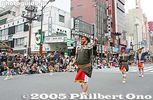
1635: Sankin Kotai Daimyo Gyoretsu. The daimyo was a warlord who owned and supervised a fief. Tokugawa Iemitsu started the Sankin kotai system where all daimyo were required to visit Edo annually at great expense. 参勤交代 大名行列The daimyo was a warlord who owned and supervised a fief. Tokugawa Iemitsu started the Sankin kotai system where all daimyo were required to visit Edo annually at great expense since they traveled in a large contingent.
参勤交代 大名行列Nov 09, 2005
|
|
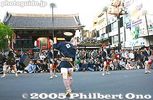
Sankin Kotai Daimyo Gyoretsu. "Gyoretsu" means procession. It was a great expense since they traveled in a large contingent. 参勤交代 大名行列Nov 09, 2005
|
|

Sankin Kotai Daimyo Gyoretsu in front of Kaminarimon Gate.参勤交代 大名行列Nov 09, 2005
|
|

Sankin Kotai Daimyo Gyoretsu palanquin. This is how the daimyo traveled--in a comfortable box hand-carried by men. 参勤交代 大名行列Nov 09, 2005
|
|

Inner palace women 大奥御殿女中Nov 09, 2005
|
|
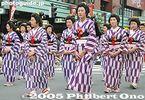
Inner palace womenNov 09, 2005
|
|
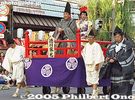
1649: Tokugawa Iemitsu. In 1649 during his reign as shogun, Asakusa Shrine was built. 徳川家光 三社権現社再建寄進Nov 09, 2005
|
|

Sankin Kotai Daimyo Gyoretsu 参勤交代 大名行列Nov 09, 2005
|
|

Lord Ii Naomasa, a right-hand man of Tokugawa Ieyasu and major ally in the Battle of Sekigahara in 1600. Based in Hikone, Shiga Prefecture. 井伊直政 徳川家康 江戸入府Nov 09, 2005
|
|

Year 1603: Tokugawa Ieyasu becomes Shogun. He designates Asakusa Temple as a place of worship, and he worships there himself in 1616. Behind him is his son Tokugawa Hidetada who became the second Tokugawa shogun. 徳川家康 江戸入府Nov 09, 2005
|
|

Inner palace womenNov 09, 2005
|
|

Inner palace women. 大奥御殿女中Nov 09, 2005
|
|
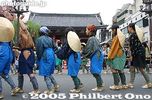
Edo Castle construction: Rock-hauling procession江戸城築城 お石曵きNov 09, 2005
|
|

Tokugawa Ieyasu takes up residence in Edo and founds the Tokugawa or Edo Period that lasted until 1868.徳川家康 江戸入府Nov 09, 2005
|
|
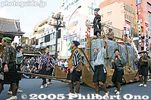
Edo Castle construction: Rock-hauling procession. Not a real boulder.Nov 09, 2005
|
|

Tokugawa Ieyasu takes up residence in Edo. 徳川家康 江戸入府Nov 09, 2005
|
|
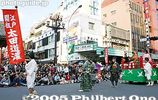
Year 1457: Ota Dokan, initial builder of Edo Castle. 江戸開祖 太田道灌、従者・山吹娘Nov 09, 2005
|
|

Year 1590: Tokugawa Ieyasu takes up residence in Edo. His procession. 徳川家康 江戸入府Nov 09, 2005
|
|
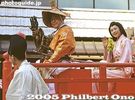
Ota Dokan, initial builder of Edo Castle. This is played by Shun'ichi Suzuki, the then governor of Tokyo. Body guards were around his float. He is dressed in a hunter's costume. Behind him is an attendant named Yamabuki.江戸開祖 太田道灌、従者・山吹娘Nov 09, 2005
|
|

Edo Castle construction: Rock-hauling procession. 江戸城築城 お石曵きNov 09, 2005
|
|

Sanja portable shrines on boats. Sanja means "Three Shrines." The three fishermen who found the Kannon buddha statue (the origin of Sensoji Temple) are deified by Asakusa Shrine next to Sensoji Temple. 三社大権現祭礼 船渡御This is the first portable shrine. The portable shrines used to be paraded in a boat.
三社大権現祭礼 船渡御Nov 09, 2005
|
|

1608: Ieyasu orders Edo Castle expansion: Rock-hauling procession. Big boulders were hauled from Izu Peninsula's east coast. 江戸城築城 お石曵きNov 09, 2005
|
|
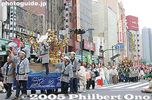
Asakusa Shrine holds the annual Sanja Matsuri in May, one of Tokyo's biggest festivals. Three portable shrines dedicated to these three fishermen are carried around the streets of Asakusa. "Sanja" means three shrines or gods. Portable shrineSecond and third portable shrines.
三社大権現祭礼 船渡御Nov 09, 2005
|
|
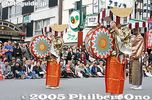
The Binzasara is a musical instrument made of 108 strips of white cedar wood strung together at the top. It is held on both ends and shaken in a wave motion to make a sharp wood clapping sound. It is also accompanied by drums as seen here.びんざさら舞
三社大権現祭礼 船渡御Nov 09, 2005
|
|
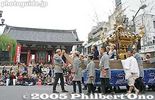
Third portable shrine. 三社大権現祭礼 船渡御Nov 09, 2005
|
|
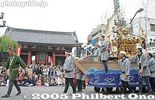
Second portable shrine. 三社大権現祭礼 船渡御Nov 09, 2005
|
|
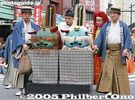
Binzasara Dance三社大権現祭礼 船渡御Nov 09, 2005
|
|

White Heron DanceNov 09, 2005
|
|

Shrine maiden and Kaminarimon Gate in Asakusa三社大権現祭礼 船渡御Nov 09, 2005
|
|

Binzasara Dance from Asakusa Shrine. They also throw confetti during the dance.This dance also originated in Asakusa by farmers who celebrated the completion of a tea house in Asakusa near the Asakusa Sensoji Temple. It is now a dance to celebrate a good harvest.
The Binzasara is a musical instrument made of small pieces of white cedar wood strung together at the top. It is held on both ends and shaken in a wave motion to make a sharp wood clapping sound.
びんざさら舞
三社大権現祭礼 船渡御Nov 09, 2005
|
|

White Heron Dance rear viewNov 09, 2005
|
|

Sarutahiko, Guardian of the earth. 猿田彦 三社大権現祭礼 船渡御Nov 09, 2005
|
|
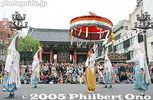
White Heron DanceNov 09, 2005
|
|
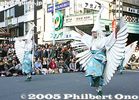
The scroll showed the White Heron Dance being performed for peace when the temple completed a major renovation. 白鷺の舞
It is one of the highlights of the festival. It is also performed on other occasions in Asakusa.
白鷺の舞
三社大権現祭礼 船渡御Nov 09, 2005
|
|
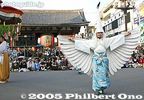
White Heron DanceNov 09, 2005
|
|
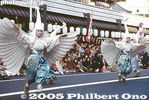
The White Heron Dance originated in Kyoto over 1,100 years ago to purge the city of an epidemic.Nov 09, 2005
|
|
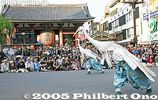
White Heron Dance in front of Kaminarimon Gate.Nov 09, 2005
|
|

White Heron Dance, Shirasagi no Mai. The eight white herons represent four male and four female herons.Nov 09, 2005
|
|

Hojo Masako worships at Asakusa Temple. 北条政子 浅草寺参拝Nov 09, 2005
|
|

White Heron Dance is one of the highlights of the festival. It is also performed on other occasions in Asakusa. The dance was revived in 1968 in Asakusa to mark the Meiji Period Centennial. It has been performed annually on Nov. 3 ever since. 白鷺の舞Nov 09, 2005
|
|

This White Heron Dance troupe consists of 3 warriors, 1 baton twirler, 1 feeder, 1 grand-umbrella holder, 8 white herons, 19 musicians and guardian children in traditional costumes of the Heian Period.Nov 09, 2005
|
|
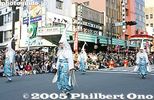
White Heron Dance, called Shirasagi no Mai, was revived in 1968 by the Asakusa tourist federation. Originating from the Heian Era, the dance was depicted in a picture scroll owned by the Sensoji Temple. 白鷺の舞It shows the dance being performed for peace when the temple completed a major renovation.
The dance troupe consists of 3 warriors, 1 baton twirler, 1 feeder, 1 grand-umbrella holder, 8 white herons, 19 musicians and guardian children in traditional costumes of the Heian Period.
It is one of the highlights of the festival. It is also performed on other occasions in Asakusa.
白鷺の舞
三社大権現祭礼 船渡御Nov 09, 2005
|
|
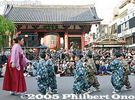
Tokyo Jidai Matsuri 三社大権現祭礼 船渡御Nov 09, 2005
|
|

Forces of Minamoto no Yoritomo (1147-1199), the founder and the 1st shogun of the Kamakura Period, who ruled from 1192 until 1199. He is said to have prayed at Asakusa Temple for victory over the Taira Clan to become shogun. 源頼朝 隅田川陣営源 頼朝 隅田川陣営Nov 09, 2005
|
|

Hojo Masako worships at Asakusa TempleNov 09, 2005
|
|

Hojo Masako (1156-1225), wife of Minamoto no Yoritomo, worships at Asakusa Temple. As the wife of the first shogun and mother of the second and third shoguns, she was a powerful lady. 北条政子 浅草寺参拝Nov 09, 2005
|
|
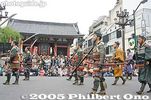
Minamoto no Yoritomo 源 頼朝 隅田川陣営Nov 09, 2005
|
|

Minamoto no Yoritomo (Hatakeyama Shigetada). His prayers for victory were answered. 源 頼朝 隅田川陣営 (畠山重忠)Nov 09, 2005
|
|
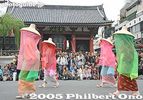
在原業平 東下りNov 09, 2005
|
|

在原業平 東下りNov 09, 2005
|
|

Ariwara no Narihira (825-880) comes to east Japan在原業平 東下りNov 09, 2005
|
|

Ariwara no Narihira (825-880) comes to east Japan. He was a Japanese waka poet and aristocrat. He was one of six waka poets referred in the preface in kana to Kokinshu by Ki no Tsurayuki. A woman portrays him. 在原業平 東下りNov 09, 2005
|
|
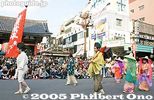
Ariwara no Narihira (825-880) comes to east Japan 在原業平 東下りNov 09, 2005
|
|
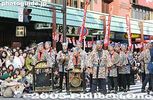
Golden Dragon Dance musiciansNov 09, 2005
|
|

Golden Dragon DanceNov 09, 2005
|
|
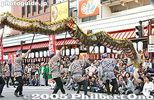
Golden Dragon DanceNov 09, 2005
|
|

Golden Dragon DanceNov 09, 2005
|
|
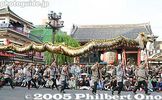
Golden Dragon Dance. No smoke or fire came out of the mouth. The dragon is 15 meters long, weighing about 80 kg. It has a bamboo frame, covered with cloth. Eight men use poles to manipulate the golden dragon.Nov 09, 2005
|
|
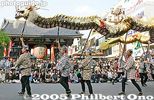
According to legend, three days after the golden Kannon statue was found, a golden dragon descended from heaven and danced. The mountain name of the temple is Kinryu-zan, meaning Golden Dragon Mountain. (Most temples have a mountain name.)Nov 09, 2005
|
|
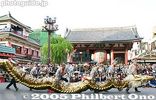
Golden Dragon Dance was first performed in 1958 to commemorate the reconstruction of Sensoji's main worship hall. 浅草のよろこび 金龍の舞Nov 09, 2005
|
|

Nov 09, 2005
|
|

Year 628: Two fishermen brothers find a golden Kannon buddha statue in Sumida River. The two fishermen were Hinokuma no Hamanari and Takenari. A wealthy landowner named Hajinomatsuchi heard about the statue and told the brothers about its religious value.He then built a small temple for the statue and the brothers converted to Buddhism. The temple eventually became today's Sensoji Temple (also called Asakusa Kannon Temple). Because of the temple, Asakusa developed and prospered and the two brothers and landlord are considered to be the founders of Asakusa.
Next to Sensoji Temple is Asakusa Shrine dedicated to these three men now deified. Asakusa Shrine holds the annual Sanja Matsuri in May, one of Tokyo's biggest festivals. Three portable shrines dedicated to these three men are carried around the streets of Asakusa. "Sanja" means three shrines or gods.
檜前浜成(ひのくまのはまなり)・竹成(たけなり)の兄弟の網に一体の小さなご仏像がかかりました。
東京のあけぼの 浅草観音示現Nov 09, 2005
|
|
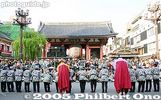
Golden Dragon Dance. 浅草のよろこび 金龍の舞Nov 09, 2005
|
|
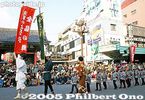
Nov 09, 2005
|
|

Magistrate Procession. Bowing to Asakusa Temple.Nov 09, 2005
|
|

Magistrate Procession 奉行Nov 09, 2005
|
|
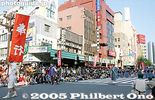
Magistrate Procession 奉行Nov 09, 2005
|
|
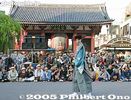
A magistrate (bugyo) in Edo could be a regional governor or government minister.Nov 09, 2005
|
|

Tekomai geishaNov 09, 2005
|
|

Tekomai geisha costume is partially masculine with trousers instead of skirts. Their right shoulder is "exposed" showing a flower design. They carry a red paper lantern imprinted with their names and use their right hand to drag a wand."Asakusa" is written on her lantern. 手古舞Nov 09, 2005
|
|
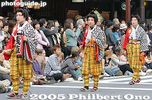
Tekomai geisha existed since the Edo Period. They served as side entertainment at festivals. They only sing traditional chant-like songs called kiyari originally sung by lumberers hauling wood. 手古舞These tekomai did not sing, so they might not be real. When they sing, they hold a fan to their mouth.
手古舞Nov 09, 2005
|
|
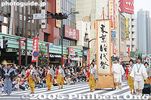
Tokyo Jidai Matsuri Banner and Tekomai geisha. From top to bottom, the banner reads, "Tokyo Jidai Matsuri." It marks the official and real start of the festival parade. The first Tokyo Jidai Matsuri was held in 1989. 東京時代祭本旗The first Tokyo Jidai Matsuri was held in 1989. Slight changes in the festival have been made since. Instead of two oiran courtesans, there is only one now. And at the end of the parade, the Asakusa Revue of showgirls used to be the anchor. But they are now gone.
東京時代祭本旗、手古舞Nov 09, 2005
|
|

Lead float with Edo festival music played by children. The names of the children playing are written on the red lanterns hanging above. Kodomo Edo-bayashi yatai 先導 子供江戸囃子屋台Nov 09, 2005
|
|

From Matsuya Department Store, the procession turns right into Kaminarimon-dori street which passes in front of the famous, giant red lantern called Kaminarimon Gate. Lead float with Edo festival music played by children. 先導 子供江戸囃子屋台Nov 09, 2005
|
|
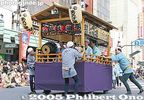
Sadly, the Tokyo Jidai Matsuri no longer held. It used to be held annually on Nov. 3 (Culture Day) in Asakusa, Tokyo.the Tokyo Jidai Matsuri (Festival of Historical Periods) is a parade tracing the history of Tokyo with over 1,600 people dressed in the respective period's costume. This is the lead float playing music. It took about an hour for the parade to reach Kaminarimon Gate.
Lead Float: Edo festival music played by children. Kodomo Edo-bayashi yatai
先導 子供江戸囃子屋台
Nov 09, 2005
|
|
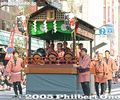
This page is a complete English guide to all the groups that appear in the parade. The parade assembles behind Sensoji Temple and starts at 1:30 pm from Nitenmon gate. The procession then goes down Umamichi-dori street, passes by Matsuya Department Store.先導 子供江戸囃子屋台Nov 09, 2005
|
|
|
|
| 834 files on 4 page(s) |
 |
4 |
|